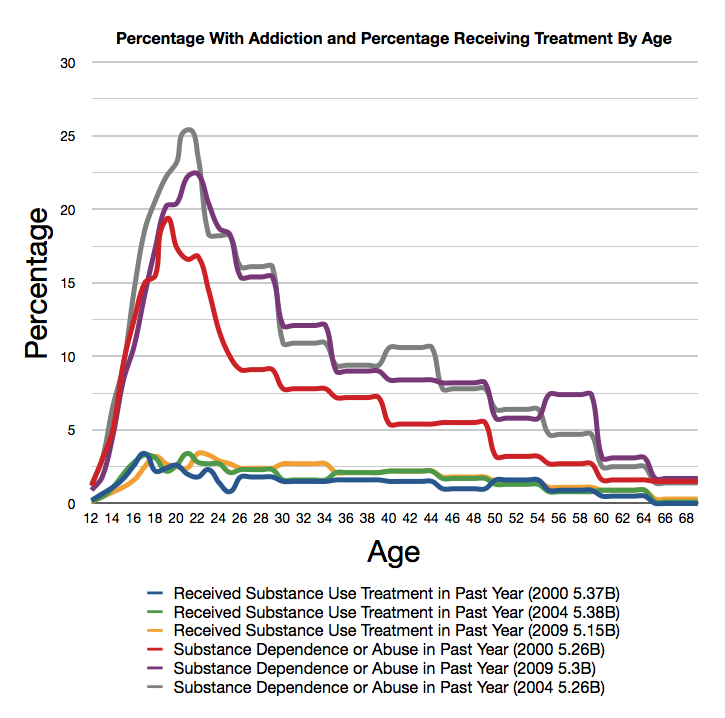The National Survey On Drug Use And Health (NSDUH) is a study carried out yearly by the Substance Abuse And Mental Health Services Administration (SAMHSA), since the late 90’s. It gives a yearly snapshot, demographically, of who is abusing substances, which substances they’re abusing, and whether they’re getting treatment or not, among other things. I made the following chart from information found in the NSDUH – it shows what percentage of americans are abusing substances (including alcohol, cocaine, marijuana, heroin, crack, hallucinogens, inhalants, and prescription drugs) by age from the years 2000, 2004, and 2009. I did this to give you a look at an important trend. Have a look:
The trend is obvious – the rate of addiction spikes in young adulthood, rapidly declines soon after, then steadily with age. I have asserted elsewhere on this blog that addiction is most often a phase that young people go through, this chart should serve as proof of that claim. For example, if you look at the gray line representing the rates of addiction in 2004 you’ll see that it spikes with 25.4% of 21 year olds addicted, but by the time we get to 30 year olds, the rate is cut by more than half, with only 10.9% addicted – and while the rates fluctuate from year to year, the trend remains the same in 2000 and 2009 – with a huge spike in addiction in the early 20’s followed by a rapid decline by age 30.
There is a big lie that we’re confronting with this data – the idea that addiction is a lifelong disease. If it were, we simply wouldn’t see such an obvious trend.
You’ll notice I also included rates of treatment in the chart – I’ve thought quite a bit about this data, and I’m not totally sure what to make of it, except that it’s further proof that a majority of people end their addictions whether or not they receive treatment.
Source: http://oas.samhsa.gov/nsduh.htm


This data is so telling, and from my research these trends have remained consistent for as long as people have been collecting data substance use. The notion of progressive, incurable disease sought to explain the very small percentage of people who continue these problematic behaviors throughout their life in spite of multiple treatment episodes. The data SAMHSA and others need to collect is the rate at which people mature out of the behavior with no treatment vs. the rate at which people “recover” with treatment. You and I both know that treatment hinders the maturation process with respect to substance use problems. To use their own terminology, treatment actually “enables” the substance user to continue their problematic behaviors.